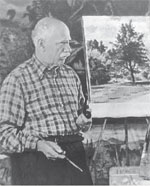 |
Y.Y. Bokshay |
A sunny and cheerful Transcarpathian art. Now one can hardly imagine how difficult and thorny was the way of this art. It has been developing during many centuries, absorbing everything the most valuable and the most beautiful from the native land and its people. The rise of the pictorial art in Transcarpathia was favoured by a number of preconditions, thanks to which the art culture, national in spirit and form, could splendidly blossom. First of all those were such factors as wonderful picturesque nature of the Transcarapthian land and not less beautiful folk art in all its genres from "pysanky", embroidery, weaving to carving on wood that has become famous not only on the objects of everyday life and decorations but also in the wonder of our region – in the wooden architecture. For the sake of this wonder not only the professional connoisseurs of beuty but also numerous tourists who have heard about the beauty of these objects created by anonymous people's geniuses come to Transcarpathia.
There was and there will remain forever one more source, without which the development of any art is impossible. This source is a people itself, a working people with pure and frank soul. It deserves a real great art that would be able to discover its best qualities.
This seemed to be necessary the more so, as in the end of the 19th century and at the beginning of the 20th in the art of many countries the process of forming and strengthening of the national art schools opposed to the official art was going on. We had before our eyes new school in Transcarpathia.
After the first world war some of our artists and me in particular managed to get acquainted with the deeply national by character works of Russian painters V. Surikov, I. Ryepin, V. Vasnyetsov, A. Arkhipov, I. Levitan. All this helped us and strengthen our idea to unite our own art forces. It was not easy at the beginning. No everybody understood the true significance of our undertaking. But good intentions prevailed. I could consider myself to be a happy man. Great artist Adalbert Erdeli, a man of big heart, who left a deep trace not only in Transcarpathian but in all Ukrainian painting, was my fellow companion in organizing the Transcarpathian school of painting. Later Omelyan Hrabovskiy joined us, he was a consistent and staunch realist who devoted all his life to the landscape painting. The main body of our union was formed by the artists A. Kotska, Z. Sholtes, A. Boretskiy, Sh. Petki, E. Kontratovych and also original F. Manaylo.
hey were young but already experienced painters at that time. Full of vital forces, they soon became the leading masters of our association.
 |
In the A. Erdeli's yard. Left to right: Y. Bokshay, F. Manaylo, A. Kotska, V. Svyda, A. Erdeli. At the foreground – E. Kontratovych, Sh. Petki. Uzhhorod, 1046. |
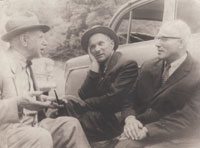 |
Talk of the artists. Y. Bokshay, Z Sholtes and H. Hlyuk. |
 |
In Uzhhorod castle. Left to right: E Hrabovskyj, F. Manaylo, L. Szoke, Z. Sholtes, A. Kashay's wife, A. Erdeli. 1955. |
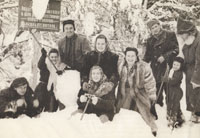 |
In the mountains in winter. Left to right: B. Marton, Z. Sholtes' wife – Sharolta, B. Hay, A. Kashay's wife – Ilona, B. Hay's wife, Z. Sholtes, A. Kotska, 1955. |
At first it was not easy for us in the living conditions of Transcarpathia of that day and find our own art language.
We have created the "Association of the workers of pictorial art of Pidkarpatska Rus". In our work we studied the old famous masters, trying to carry through our life a great respect to the treasures created by Rembrandt and Velazquez, Goya and Tiepolo, Munkacsi and Courbet. We aimed at separating our art from the art of amateurs, unfounded "avant-guard" and official salon style manner.
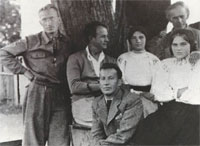 |
Left to right: A. Kotska, A. Erdeli and A. Boretskyj with inhabitants of Verkhovyna at plian air (second half of 1930s). |
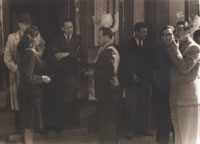 |
First of May demonstration in Uzhhorod. |
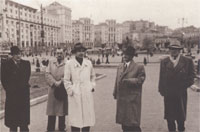 |
In Khreshchatyk. Left to right: trade union leader, A. Kashay, A. Erdeli, B. Marton. Kyiv, 1953 |
 |
First of May demonstration in Uzhhorod. Left to right: F. Manaylo, Khokhlov, A. Erdeli, E. Hrabovskiy, A. Kashay, A . Boretskiy, A. Kotska, Z. Sholtes, 1954. |
A new period of the art and organizational activities started after 1944, when Transcarpathia was liberated from the German invaders by the Soviet army, and our artists obtained the possibilities of creative work not seen before. Our collective has grown and has become stronger. Our friends and connoisseurs – millions of spectators made up an audience one could only dream of. We got on the broad road of art. The new masters that appeared in our rows were A. Kashay, H. Hlyuk, sculptors V. Svyda, I. Harapko, graphic V. Berets. Together with the famous masters they have enriched the Transcarpathian art with new thrilling themes which depict the modern reality. Optimism has become once and forever the main feature of the work of Transcarpathian artists, of their colourful, sunny and bright art.
In Uzhhorod an art gallery was opened and an art school was founded in which generations of masters of painting, graphics, applied art were educated.
 |
Vasyl Habda's wedding. |
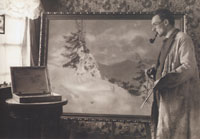 |
Zoltam Sholtes in his studio. |
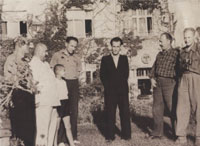 |
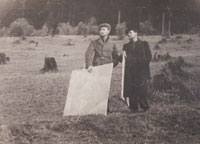 |
In search of motifs. A. Kashay and Z. Sholtes, 1954. |
Many Transcarpathian painters who later graduated from the higher art institutions in Kyiv, Lviv, Leningrad and Moscow had started their creative life in this school. They are A. Shepa, E. Medvetska, M. Medvetskiy, V. Mykyta, V. Habda, P. Balla, V. Zvenyhorodskiy, E. Kremnytska, I. Ilko, N. Herts, Yu. Herts, I. Shutev, A. Dunchak, C. Malchytskiy, V. Sabov, V. Burch, O. Burlin, sculptors M. Popodych, K. Lozoviy, A, Horvat, L. Brovdi, I. Brovdi. P. Bedzir, V. Skakandiy, Yu. Stashko, I. Garani, A. Marton, M. Mytryk seriously and deeply work out the principles of graphic art.
Y.Y. Bokshay
The editorial board is thankful to Stepan Sholtes, Honoured artist of Ukraine, who allowed to use the photographs from the book about his father “Zol;tan Sholtes. 1909-1990”, Lviv, 2009.









